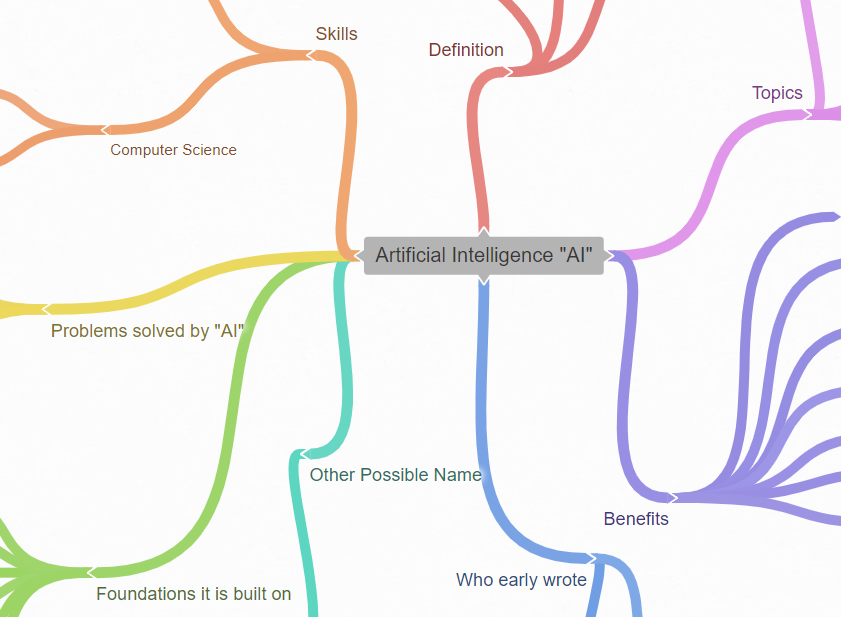In the name of Allah, most gracious and most merciful,

It is astounding how much information I found on writing about this topic. AI is the big umbrella under which there are most of those topics I mentioned in that post.
Since I am giving a large overview, I will just try to pick a small number of words for talking about the definitions, topics, skills, etc. It is the zoom-out phase of the analysis. I have mentioned the references at the end of this post for those who want more details about what is mentioned here.
Since I will not give much details so don’t expect to understand everything from this post. It is just the big picture. After this I intend to have a separate blog post for each of the Artificial Intelligence topics.
Table of Contents
1. Definition
Artificial intelligence (AI) is a computer science branch for building smart machines that could preform tasks that usually require human intelligence.
1.1 Weak AI (“Narrow AI” or “Artificial Narrow Intelligence (ANI)”)
It focuses on doing one task really well. It is still far beyond real general human intelligence.
1.2 Strong AI (“General AI” or “Artificial General Intelligence (AGI)”)
It tries to imitate real human intelligence. It can think, understand, and act similar to human.
1.3 Super AI (“Super Intelligence” or “Artificial Super Intelligence (ASI)”)
It exceeds human intelligence and abilities. It is the best at everything including science, math, history, etc.
Useful Introduction for Connecting the AI Dots
For the computer to be intelligent, we would need it to possess the following capabilities which are the major AI subfields:
- Natural Language Processing: For communicating with humans
- Knowledge Representation: For storing information (what it knows, sees, or hears).
- Automated Reasoning: For using the stored information for drawing conclusions and answering questions
- Machine Learning: For detecting patterns, and adapting to new circumstances
- Computer Vision: For perceiving objects
- Robotics: For moving and manipulating objects
2. Topics
The following are the major topics in AI but they are not the only topics under the AI umbrella. In addition to this, I have also included topics that have a big intersection of AI although they are not totally under the AI umbrella.
2.1 Machine Learning “ML”
The use of AI for enabling machines to learn a task from experience without being specifically programmed to perform that task step by step. In other words, machines are coding their program details by themselves but the programmer is setting the proper environment for these machines to learn and ensure that they are actually learning.
Deep Learning “Neural Networks”
It is a branch of machine learning that learns by using a certain algorithm “Neural Networks” that imitates the human brain structure. Their power lies in that these artificial neural networks could detect highly non-linear complex patterns.
2.2 Reinforcement Learning “RL”
The machine learns similar to humans which is by trial and error. Therefore the next action is decided by the algorithm by learning behaviors based on the current state and the goal of maximizing the reward in the future.
2.3 Robotics
This field is concerned with creating humanoid machines that could behave like humans by taking intelligent actions in different situations. They could also solve problems in a limited domain and could even learn in controlled environments
2.4 Natural Language Processing “NLP”
It is concerned with making machines analyze and understand human language that they could even respond to you automatically like chatbots. NLP has many subtopics including machine translation, speech recognition, and natural language generation.
2.5 Computer Vision “CV”
It is concerned with extracting information from images. This information could be an object in an image “object detection” and it could identify the image content for grouping images with similar content together, etc.
2.6 Knowledge Engineering
It is an AI subfield that is concerned with the design, development, and maintenance of agents that perform problem-solving and decision-making tasks using knowledge and reasoning.
Knowledge engineering involves human experts’ cooperation to codify and make the rules (or other procedures) that a human expert uses to solve real problems explicitly.
2.7 Cognitive Computing
It is the use of computerized models for simulating the human thought process in complex situations where the answers may be vague. It overlaps with AI and requires many of the similar technologies for powering cognitive models and applications like Expert Systems, Neural Networks, Robotics, Virtual Reality “VR”, machine learning, NLP, and sentiment analysis.
It is useful to know that human cognition requires real-time analysis of the environment, context, and intent as well as many other variables that affect human’s problem-solving ability.
AI Big Map (Artificial Intelligence: A Modern Approach Textbook Table of Contents)
Of course, you don’t have to learn all of these. This is a big overview of AI to see where each of the major subfields of AI exists in the big AI map. Being aware of the connections of AI and where are you in the AI map could be very helpful for you in connecting the dots during learning.
- Artificial Intelligence
- Introduction
- Intelligent Agents
- Problem-solving
- Solving Problems by Searching
- Beyond Classical Search
- Adversarial Search
- Constraint Satisfaction Problems
- Knowledge, reasoning, and planning
- Logical Agents
- First-Order Logic
- Inference in First-Order Logic
- Classical Planning
- Planning and Acting in the Real World
- Knowledge Representation
- Uncertain knowledge and reasoning
- Quantifying Uncertainty
- Probabilistic Reasoning
- Probabilistic Reasoning over Time
- Making Simple Decisions
- Making Complex Decisions
- Learning
- Learning from Examples (includes Supervised Learning, Artificial Neural Networks, and Practical Machine Learning)
- Knowledge in Learning
- Learning Probabilistic Models
- Reinforcement Learning
- Passive Reinforcement Learning
- Active Reinforcement Learning
- Generalization in Reinforcement Learning
- Policy Search
- Communicating, perceiving, and acting
- Natural Language Processing
- Language Models
- Text Classification
- Information Retrieval
- Information Extraction
- Natural Language for Communication
- Phrase Structure Grammars
- Syntactic Analysis (Parsing)
- Augmented Grammars and Semantic Interpretation
- Machine Translation
- Speech Recognition
- Perception “Computer Vision”
- Image Formation
- Early Image-Processing Operations
- Object Recognition by Appearance
- Reconstructing the 3D World
- Object Recognition from Structural Information
- Using Vision
- Robotics
- Robot Hardware
- Robotic Perception
- Planning to Move
- Planning Uncertain Movements
- Moving
- Robotic Software Architectures
- Application Domains
- Natural Language Processing
- Conclusions
- Philosophical Foundations
- Weak AI: Can Machines Act Intelligently?
- Strong AI: Can Machines Really Think?
- The Ethics and Risks of Developing Artificial Intelligence
- AI: The Present and Future
- Agent Components
- Agent Architectures
- Are We Going in the Right Direction?
- What If AI Does Succeed?
- Philosophical Foundations
3. Benefits
AI is increasingly impacting our world. It is benefiting many fields in various ways, and it will continue changing the world in the future.
Here are some of the benefits of AI.
- Automation: Increasing production rates, productivity, product quality, safety, and more efficient use of raw materials.
- Medical Advances: Remote patient monitoring technology, monitoring the progression of contagious diseases, detecting diseases, and even predicting their future effects.
- Research and Data Analysis: Using algorithms to analyze data more efficiently and for creating better predictive models that understand the suitable patterns in the data and predict outcomes of different scenarios. In addition to this, the great computing powers are processing a huge amount of data to get insights from while that would have taken much time for humans to review and understand.
- Solving Complex Problems: AI is helping businesses in different industries to find better solutions for their different complex problems including fraud detection, customer segmentation, medical diagnosis, and so on. Better solutions could increase productivity and reduce expenses.
- Business Continuity: Help businesses respond proactively to possible crises while helping in developing fast disaster recovery strategies.
- Minimizing Errors: Which could help businesses that couldn’t afford even very small error.
- 24/7 Availability: Machines don’t need frequent breaks as humans.
4. Who wrote early about “AI” and Who Coined the “AI” term
In the 1940s and 50s, many scientists from different fields (mathematics, psychology, engineering, economics, and political science) started to discuss the possibility of artificial brain creation.
AI was formally founded at1956 when the term “Artificial Intelligence” was coined at a conference at Dartmouth College, in Hanover, New Hampshire. However, the beginning of AI could be traced to early philosophers’ trials for describing human thinking symbolically.
A paper with the title “Computing Machinery and Intelligence” was published in 1950 by the English Mathematician Alan Turing which has opened the doors for the AI field. Later the community adopted the term Artificial Intelligence as coined by professor John McCarthy.
5. “AI” Other Name
I didn’t find other names for AI. However, Computational Intelligence is something that have intersection with AI and could be seen as another AI sub-field.
Computational Intelligence (CI) emphasizes on the design, application and development of biologically and linguistically motivated computational models. It is the study of adaptive mechanisms that enables or facilitates intelligent behavior in complex and changing environments.
6. Foundations upon which “AI” is built
AI lives within the intersection of many fields.
- Philosophy: From where does knowledge come?
- Linguistics: What is the relation between language and thought?
- Neuroscience: How does our brain process information?
- Behavioral Economics: How decisions are made for maximizing utility?
- Mathematics: What are the computations needed for AI?
- Computer Science: How could we build AI using computer science?
7. Examples of Problems solved by “AI”
- Frauds Prevention
- Producing more crops with fewer resources
- Identifying diseases even before they occur
- Making E-learning much interactive and fun
- Making safer driving using Self-Driving Cars
- Interactive Teacher Assistant “TA” that could answer many questions in online courses
- Help us consume energy in a smarter way
8. Skills needed to work in the AI field
The AI has many subfields, so depending on the specific field there are specific skills needed for that field. However, generally there are some common skills that mostly anyone working in “AI” should have. These skills are:
- Math: Statistics, Probability (General) – Calculus, Linear Algebra, and Logic (Could be useful for most AI endeavors but not necessarily all of them)
- Computer science: Algorithms & Data Structures, and Programming (especially Python)
Generally, I think you have to first specify what exact field you want to specialize in to make a plan for step-by-step skill acquisition until you finally acquire the needed skills. But while figuring out which field is most suitable for you, you could start learning these skills since they are common between different AI fields.
Finally
Thank you. I hope this post has been beneficial to you. I would appreciate any comments if anyone needed more clarifications or if anyone has seen something wrong in what I have written in order to modify it, and I would also appreciate any possible enhancements or suggestions. We are humans, and errors are expected from us, but we could also minimize those errors by learning from our mistakes and by seeking to improve what we do.
Allah bless our master Muhammad and his family.
References
https://builtin.com/artificial-intelligence
https://www.geeksforgeeks.org/8-best-topics-for-research-and-thesis-in-artificial-intelligence/
https://www.10xds.com/blog/benefits-of-artificial-intelligence-ai/
https://www.livescience.com/49007-history-of-artificial-intelligence.html
https://en.wikipedia.org/wiki/History_of_artificial_intelligence
https://courses.cs.washington.edu/courses/csep590/06au/projects/history-ai.pdf
https://www.edureka.co/blog/types-of-artificial-intelligence/
https://searchenterpriseai.techtarget.com/definition/cognitive-computing
http://www.differencebetween.net/technology/difference-between-ai-and-ci/
https://www.educba.com/advantages-of-artificial-intelligence/
https://towardsdatascience.com/foundations-of-ai-b11d6ad7ce6f
https://cis.ieee.org/about/what-is-ci
https://becominghuman.ai/10-real-world-problems-effectively-solved-by-the-ai-485f2f0c555c
https://www.weforum.org/agenda/2017/02/5-global-problems-that-ai-could-help-us-solve/
https://www.amazon.com/Artificial-Intelligence-Modern-Approach-3rd/dp/0136042597
https://www.amazon.com/Knowledge-Engineering-Cognitive-Assistants-Evidence-based/dp/1107122562

